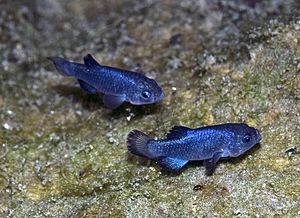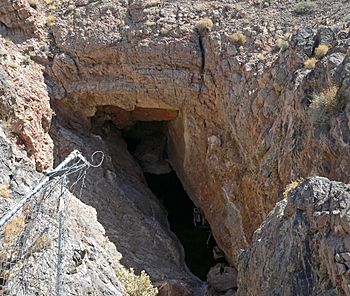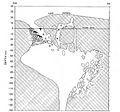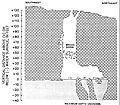Devils Hole facts for kids
Devils Hole is a unique natural spot found within the Ash Meadows National Wildlife Refuge in Nye County, Nevada, in the Southwestern United States.
This special place is a part of Death Valley National Park. It's the only natural home for a very rare fish called the Devils Hole pupfish (Cyprinodon diabolis). The area around Devils Hole is about 40 acres (16 ha). It's part of the larger Ash Meadows National Wildlife Refuge complex, which includes desert lands and oases fed by springs. This whole area became a National Wildlife Refuge in 1984.
Contents
What is Devils Hole?
Devils Hole is a warm pool inside a limestone cave in the Amargosa Desert of Nevada. It's located east of Death Valley, past the Amargosa Range and Funeral Mountains.
The pool is about 730 m (2,400 ft) above sea level. The water stays at a constant temperature of 33 °C (91 °F) (about 91°F). The surface of Devils Hole is about 22 meters (72 feet) long and 3.5 meters (11.5 feet) wide. There's a small rock shelf about 0.3 m (0.98 ft) deep at one end, which is about 3.5 by 5 m (11 by 16 ft) in size.
The water in Devils Hole has low dissolved oxygen. This means there isn't much oxygen for animals to breathe. However, the shallow shelf can have more oxygen, especially in June and July.
The Deep Cave
Devils Hole goes deep into the ground, branching into caverns that are at least 130 m (430 ft) (426 feet) deep. No one has ever mapped the very bottom of these caverns. Geologists believe these caves formed more than 500,000 years ago.
Interestingly, the water in the pool often moves and sloshes around because of earthquakes happening far away. Even big earthquakes in places like Japan, Indonesia, and Chile can cause small tsunami-like waves in Devils Hole.
The Devils Hole Pupfish

Devils Hole is the only natural home for the Devils Hole pupfish. This fish is amazing because it lives well even in the hot, oxygen-poor water. Some people say Devils Hole might be the smallest habitat in the world that holds all the individuals of a single animal species.
The pupfish is considered critically endangered by the IUCN. This means it's at a very high risk of disappearing forever. It's often called the world's rarest fish. Since 2005, there have been fewer than 200 pupfish in the wild.
Pupfish History and Protection
Scientists believe the pupfish species is as old as Devils Hole itself. The hole opened to the surface about 60,000 years ago.
The pupfish has been protected since 1967, when it was declared an endangered species. There were some legal disagreements in the 1980s about who owned and could use the groundwater around Devils Hole. These issues led to even more protection for the pupfish.
However, since the late 1990s, the number of pupfish has gone down a lot. Scientists aren't completely sure why this is happening. One idea is that a tiny, non-native diving beetle might be eating the pupfish eggs.
Images for kids
See also
 In Spanish: Hoyo del Diablo para niños
In Spanish: Hoyo del Diablo para niños




